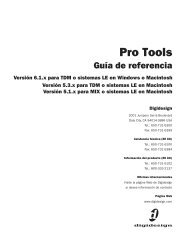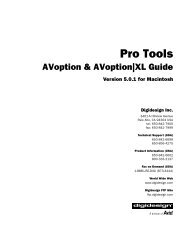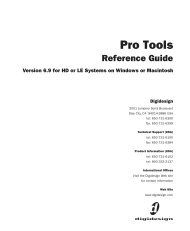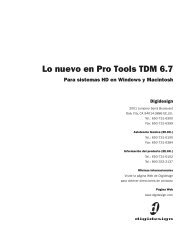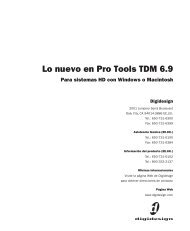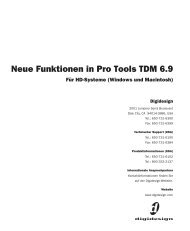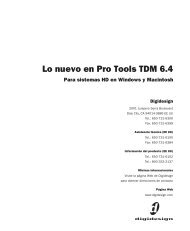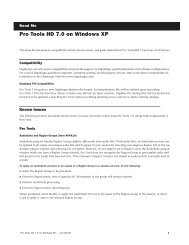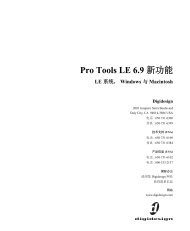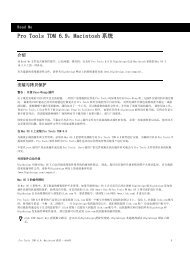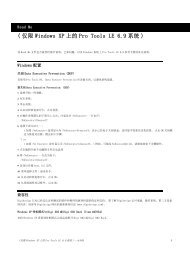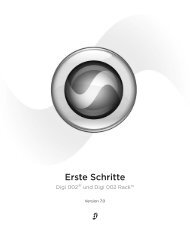5.1 DigiRack Plug-Ins Guide - Digidesign Support Archives
5.1 DigiRack Plug-Ins Guide - Digidesign Support Archives
5.1 DigiRack Plug-Ins Guide - Digidesign Support Archives
You also want an ePaper? Increase the reach of your titles
YUMPU automatically turns print PDFs into web optimized ePapers that Google loves.
Attack Sets the attack time of the Gate.<br />
Hold Specifies a duration (in seconds or milliseconds)<br />
that the Gate will stay open after the initial<br />
attack cycle. This can be used as a one-shot<br />
function to keep the Gate open for longer periods<br />
of time with a single crossing of the threshold.<br />
It can also be used to prevent gate chatter<br />
which may occur if varying input levels near the<br />
threshold cause the Gate to open and close very<br />
rapidly.<br />
Decay Controls how long it takes for the Gate to<br />
close after the signal falls below the threshold<br />
level.<br />
Range Sets the depth of the Gate when closed. It<br />
has a maximum depth of -80db. Setting the gate<br />
to higher range levels allows more of the gated<br />
audio that falls below the threshold to peek<br />
through the gate at all times. This is useful for<br />
things such as drum leakage, where you may<br />
want to suppress the overall drum kit sound by<br />
a specific amount, while emphasizing the gated<br />
instrument such as a snare.<br />
Graph Displays the response curve set by the<br />
Gate’s Threshold and Range settings. As you adjust<br />
these parameters, refer to the graph to see<br />
how the shape of this curve changes. This will<br />
allow you to see the effect of your settings.<br />
External Key Enables and disables side chain<br />
processing. Side chain processing allows the<br />
Gate to listen to the varying amplitude of a separate<br />
reference track and use it to trigger limiting.<br />
See “Using a Key Input for Side Chain Processing”<br />
on page 34.<br />
Key Listen When enabled, this allows you to listen<br />
to the reference track controlling the side<br />
chain input. This is often useful for fine tuning<br />
the Gate’s settings to the key input.<br />
Expander/Gate II<br />
Expander/Gate II plug-in<br />
The Expander/Gate reduces noise by decreasing<br />
the gain of signals that fall below a user-selectable<br />
threshold. Expanders are particularly useful<br />
for reducing noise or signal leakage that creeps<br />
into recorded material as its level falls, as often<br />
occurs in the case of headphone leakage.<br />
Expanders can be thought of as soft noise gates<br />
since they provide a gentler way of cutting off<br />
noisy low-level signals than the typically abrupt<br />
cutoff of a gate. If you want, however, you can<br />
actually use this plug-in as a gate, simply by setting<br />
the Ratio to its maximum value and using<br />
short attack, decay, and release settings.<br />
Expander/Gate Parameters<br />
Phase Invert Inverts the phase (polarity) of the<br />
input signal, allowing you to change frequency<br />
response characteristics between multi-miked<br />
sources or to correct for miswired microphone<br />
cables.<br />
Reduction Meter Indicates the amount of signal<br />
reduction in dB.<br />
Chapter 4: <strong>DigiRack</strong> Real-Time TDM and RTAS <strong>Plug</strong>-<strong>Ins</strong> 31



